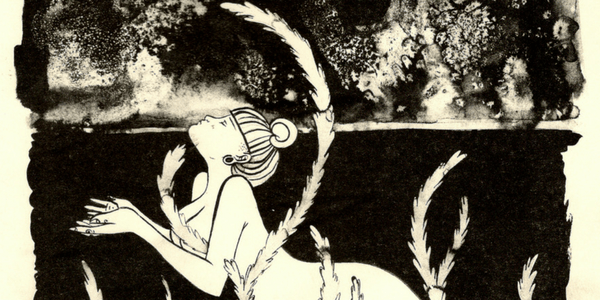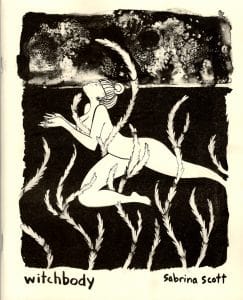
 witchbody, by Sabrina Scott
witchbody, by Sabrina Scott
Perfectly Acceptable Press, unpaginated, 2015
A lushly illustrated zine, witchbody doubles as a visceral call to immerse oneself in the world, to embody the magick of the everyday, and to be responsible for the environments in which we live. As a limited edition talismanic object blessed under the August full moon, it is infused with spirit.
In the introduction, Sabrina Scott presents the zine as an object to be experienced bodily. witchbody is meant to be touched, felt, smelled, and tasted — not just seen and read. If you listen closely, you may even hear it.
For Scott, to be a witch is to privilege the body and use it as a site to investigate the self and other beings. She invites the reader to contemplate the magick of pizza, and whatever is immediately present. She writes that magick is about change, and I can’t agree more. Scott calls for an internalization of nature, and the recognition that all things are natural. “The beauty of being [is] rooted… in the flux of process, of transformation,” she writes.
Particularly as it relates to the other-than-human, Scott entreats us to move beyond our anthropocentric instinct, and immerse ourselves in the world of the everyday, the immediate, and find meaning and connection — to revel in things that might otherwise repel us. We ought to move beyond the “pure” and pristine, and seek to engage with the world we live in, noisy and polluted as it is. As Scott says, “for the witch, nature is everywhere.”
If we expand our understanding of what constitutes a “natural” environment and include the world in which we input everyday, the concrete jungles and suburban sprawls that make up our lives take on new significance. Implicit in Scott’s critique is a rejection of the pastoral vision typically held by many contemporary practitioners. Lush forests and open fields fragrant with wild flowers aren’t the only places to seek magick or the divine. With witchbody, Scott reminds us that if we immerse ourselves in the environments in which we actually live, we can experience a deeper connection to magick, and to ourselves.
witchbody is gorgeously illustrated with clear line drawings done in black ink, rich with unexpected details: a skull here, a fox there. Tiny bees. The text is handwritten and, charmingly, mistakes are scratched out, which also serves to heighten the sense of intimacy with this very human work.
The illustrations exemplify the theory presented in the text as practice. Cleaning garbage out of a lake while philosophizing about our connection to what constitutes our natural world, finding beauty in trash bin, and finding peace in urban settings. Urban environments have their own charm, their own nature, and if we disconnect ourselves from that, we’re missing out.
Scott’s endnote frames the project of witchbody, and also provides the reader with a reading list of other thinkers to consider. Some of these were familiar to me (Maurice Merleau-Ponty, Donna Haraway, Robert Cochrane), while others who were important to Scott’s work have inspired a new reading list for me (namely, Jane Bennett, Ian Bogost, Sarah Ahmed).
witchbody is smart, beautiful, and highly recommended.








